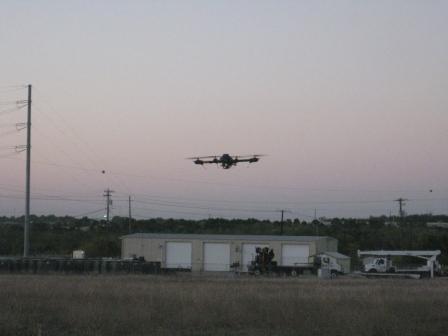How a doctoral student built an oversized UAV by learning PCB design.
Miki Szmuk is an aerospace engineer with big ideas for building better unmanned aerial vehicles (UAV). As a doctoral student from the Controls Lab for Distributed and Uncertain Systems (C-DUS) of the Department of Aerospace Engineering at the University of Texas (UT) in Austin, Szmuk specializes in the engineering of small, sophisticated UAVs. 
Szmuk and the rest of the C-DUS research group are advised by Dr. Maruthi Akella. The team focuses on addressing fundamental engineering problems in nonlinear dynamical systems, measurements, and control. This includes the coordinated operation of distributed multi-vehicle swarms. Consequently, the C-DUS research group employs UAVs in demonstrating various control and estimation algorithms that it develops.
These crafts are not easy to build. Weighing only a few pounds, UAVs must travel long distances, reliably collecting and processing data along the way. To meet the always evolving needs of the UAV industry, Szmuk recognized the need to develop PCB design skills. Without them, it would be difficult to cost effectively improve functionality of his department’s drones and get in front of industry expansion.
Size issues. Szmuk first reached out to Sunstone Circuits as an undergraduate at UT. “I was working on a UAV with a two-and-a-half pound autopilot system,” said Szmuk.
The vehicle’s overall size is a function of the payload it must carry, and it took a 25- to 30lb. UAV just to accommodate the oversized autopilot. “That was simply too big for what we needed this plane to do,” said Szmuk.
Issues with size compound quickly when building a UAV. If the autopilot is too big, that impacts the wing area and fuselage size. The result is an oversized craft with less functionality and a higher cost.
“When it comes to drones, smaller is better, so payload size is critical,” said Szmuk.
The cumbersome, original UAV design was done component by component, thus the oversized end-product. Szmuk took it upon himself to look at the bigger picture. “Looking at the plane, it was just a rat’s nest of wires,” he said.
Szmuk called Sunstone, looking not just for a company to manufacture boards but for a way to design them himself. With its help, he designed his first PCB – a small board that routed the plane’s wiring in a more organized and efficient way. The board helped reduce the size of the autopilot and enabled other refinements such as the replacement of a baseball-size sensor with a small chip.
“Once the board was integrated into the overall UAV design, we were able to keep making choices that made the plane smaller,” said Szmuk.
As the autopilot design evolved, the system shrank from its original weight of over two pounds down to just 13g. As a result, the next version of the craft weighed just 20% of its predecessor.
Szmuk continues to develop smaller, higher performance UAVs. Using the fabricator’s software, PCB123, and manufacturing help, he has made increasingly complex circuits to trim bulk and increase capabilities. “Even though PCB123 is really easy to use, and I was able to teach myself a great deal, Sunstone did a lot to help me become a better designer,” said Szmuk.
A project funded through NASA required Szmuk to demonstrate novel guidance algorithms and build his smallest UAV to that point. These algorithms were geared toward improving the autonomy of unmanned climate science missions in the Arctic. “Sunstone was a big help on that one,” said Szmuk. “They had people take a look at my designs to make sure they were feasible, and that really reduced our stress levels.”
Szmuk’s early projects required only a handful of boards be produced at a time, because the overall UAV design would evolve and the board requirements would change.
“Sunstone takes a long-term approach to projects like Miki’s,” said Sunstone's David Warren. “We made it possible for him to keep improving his UAV without busting the department’s budget.”
Szmuk now relies on Sunstone to support all of his UAV projects. With Sunstone consistently making it possible for an engineer to excel as a PCB designer, Szmuk has achieved more with fewer resources.
Szmuk now pursues his doctorate, and he trusts his PCB designs will produce the boards needed to break new ground in the unmanned vehicle industry. As that industry expands into a myriad of civil and public safety services, Szmuk knows his increasingly diverse and complicated projects will succeed without the outside help of a designer.
“After working with Sunstone for years, I’ve had a very good experience, and they’ve never let me down. I’m very thankful for the work they’ve done,” said Szmuk.
Ed.: This was adapted from a recent case study by Sunstone and is published with permission.
The Growing UAV Industry
Originally used for military or special operations, UAVs are now used for an increasing number of civil purposes. These include:
• Maritime or mountain search and rescue.
• Monitoring of waterways, oil pipelines and civil engineering sites.
• Disaster management.
• Crop management.
As the uses for UAVs become more diversified, design challenges will vary significantly depending on how they must function in the field.















